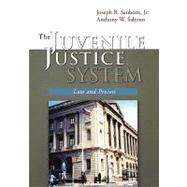
Note: Supplemental materials are not guaranteed with Rental or Used book purchases.
Purchase Benefits
What is included with this book?
| A History of Juvenile Justice in the United States | |
| Putting Juvenile Justice Into Context | |
| Some Preliminary Distinctions | |
| Models or Philosophies of Juvenile JusticeImpact of the Rehabilitation Model | |
| The Varied Purposes of Juvenile Justice | |
| The Terminology Differentiation | |
| Historical Development of Juvenile Justice | |
| Quakers'' Reform Efforts in the Nineteenth Century | |
| Houses of Refuge | |
| Legal Foundation for the Houses of Refuge | |
| Reformatories and Separate Trial Dockets | |
| The Emergence of the Juvenile Court | |
| The Legal Foundation of Juvenile Court | |
| The Reasons Juvenile Defendants Had No Rights in Juvenile Court | |
| The Juvenile Justice System, 1899-1967: An Overview | |
| United States Supreme Court Intervention: The Legal Framework of Juvenile Justice | |
| The Need for Changes in Juvenile Court Procedures | |
| Establishing the Legal Framework of Juvenile Justice in Kent v. U.S.In re Gault and the Modification of Juvenile Court Procedure | |
| Putting Gault and the Legal Framework Into ContextIn re Winship and the Burden of Proof | |
| and the Right to Jury Trial | |
| Trial in Both Juvenile and Adult Court | |
| The Overall Result of the Legal Framework | |
| The Nature of Juvenile Misbehavior | |
| Juvenile Court Jurisdiction | |
| Factors Influencing Jurisdiction | |
| Juvenile Delinquency | |
| Status Offenses | |
| Mandatory Exclusion | |
| Measuring Juvenile Crime | |
| Measuring Juvenile Delinquency | |
| Uniform Crime Reports | |
| Victimization Surveys | |
| Self-Report Surveys | |
| Validation of SRSCohort Studies | |
| Evaluating Measures of Juvenile Delinquency | |
| Age and Delinquency | |
| Gender and Delinquency | |
| Race and Delinquency | |
| Social Class and Delinquency | |
| Juveniles Preying on Juveniles: Juveniles as Victims | |
| Patterns of Juvenile Crime | |
| Considering Patterns | |
| Crime in the Schools | |
| GangsJuvenile Violent Crime | |
| Serious Violent Juveniles (SVJ) | |
| The Gatekeepers of Juvenile Justice | |
| Policing Juveniles | |
| Policing: The Underdeveloped Component | |
| Unique Police Service and Prevention Roles | |
| Juveniles'' Attitudes Toward Police | |
| Community-Oriented Policing | |
| Curfew LawsDetecting Youth Misbehavior | |
| Field Investigations and Stops and Frisks | |
| The Decision Not to Arrest a Youth | |
| Grounds and Evidence for Arrest (Taking Into Custody)Factors That Can Affect the Decision to Arrest | |
| Procedures Following Arrest | |
| Search and Seizure and Interrogation | |
| Fingerprints and Photographs | |
| Other Identification MeasuresThe Decision to Refer the Case to Juvenile Court | |
| The Juvenile Court PersonnelA Unique Place to Work | |
| The Prosecutor | |
| The Defense Attorney | |
| The Judge | |
| Referees and Masters | |
| Probation Officers | |
| Parents and Victims | |
| Personnel Overview | |
| The Intake ProcessIntake Objectives | |
| POs as Intake Workers | |
| The Uniqueness of IntakeIntake OptionsIntake Decision Making | |
| The Essence of DiversionFailure, Successful Completion, and Impact of Diversion | |
| Modern Aspects of Diversion | |
| Research on Who Is Diverted | |
| The Formal Prosecution Option | |
| The Numbers at Intake | |
| The Juvenile Court: The Preliminary Stages | |
| DetentionPOs as the Gatekeepers to Detention | |
| Humane Detention | |
| The Detention Alternative Movement | |
| Detention SettingsJuveniles in JailJuveniles Eligible for Detention | |
| Detention Research | |
| Risks (and Needs) Assessment | |
| Detention Hearing | |
| Constitutional Rights at the Detention Hearing | |
| The Need to Detain | |
| Release Conditions | |
| Addressing the Charges at Detention | |
| The Numbers at Detention | |
| Expedited Trial Date for Detention Cases | |
| Potential Unique Aspects of Juvenile Detention | |
| The Pretrial Stage | |
| An Underdeveloped StagePleading | |
| Pretrial IssuesInformal Resolutions | |
| Plea Bargaining | |
| Non-negotiated Guilty Pleas | |
| The Pleading Guilty Process | |
| Heading to Transfer or to an Adjudicatory Hearing | |
| Transfer to Adult Court | |
| The Prospect of Self-Transfer | |
| The What of Transfer | |
| The Why of Transfer | |
| The When of Transfer | |
| The How (or Types) of Transfer: Judicial and Prosecutorial | |
| The First Stage of Judicial Transfer: The Probable Cause Hearing | |
| The Second Stage of Judicial Transfer: The Amenability Hearing | |
| Prosecutorial Transfer | |
| Current Standards in Judicial a | |
| Table of Contents provided by Publisher. All Rights Reserved. |
The New copy of this book will include any supplemental materials advertised. Please check the title of the book to determine if it should include any access cards, study guides, lab manuals, CDs, etc.
The Used, Rental and eBook copies of this book are not guaranteed to include any supplemental materials. Typically, only the book itself is included. This is true even if the title states it includes any access cards, study guides, lab manuals, CDs, etc.